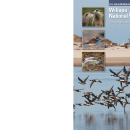What We Do
Willapa National Wildlife Refuge faces many unique management challenges. While the refuge includes many pristine areas, it also includes lands where considerable restoration effort is needed. With the amazing diversity of habitats, from ocean sand dune beaches to the sheltered mudflats of the bay, from pristine old growth forests to open salt grass meadows, an equal diversity of conservation efforts must be employed. The refuge is home to several threatened species, and is trying to restore habitat for many others. Like many places, Willapa NWR is also coping with the threat of invasive species invasive species
An invasive species is any plant or animal that has spread or been introduced into a new area where they are, or could, cause harm to the environment, economy, or human, animal, or plant health. Their unwelcome presence can destroy ecosystems and cost millions of dollars.
Learn more about invasive species .
To help plants and wildlife, refuge staff use a variety of habitat management techniques to maintain, recover or enhance plant and wildlife values. Refuge staff carefully consider any management techniques and employ them in varying degrees according to the situation.
Sometimes, sensitive areas are closed to the public so that the land or species can recover more quickly. Mowing, tilling, seeding and the control of water levels are some of the techniques used to help native plants recover for the benefit of other wildlife. Mechanical removal or application of herbicides is also used to control invasive plant species, such as spartina, gorse and non-native beach grasses.
Standardized ground and aerial wildlife surveys and vegetation surveys are conducted on the refuge throughout the year to inventory populations and document habitat use. Units are evaluated by how well they meet habitat and wildlife use objectives.
Public involvement and input are important to us and to the planning process, and we hope you will take an active interest in the process, individually and as a community.
Management and Conservation
Conservation efforts are guided and directed by the Refuge's Comprehensive Conservation Plan which was last approved in 2011. Goals include:
Protect, maintain, and restore:
- ecologically functional late-successional forest habitats (mature and old-growth forest) characteristic of the low-elevation temperate forests in the southwest Washington coastal region for the benefit of endangered and threatened species, migratory and resident birds, and a diverse assemblage of other native species.
- estuarine habitats historically characteristic of the southwest Washington coastal region for the benefit of salmonids, Pacific brant, other waterfowl, shorebirds, seabirds, and a diverse assemblage of other native species.
- freshwater habitats historically characteristic of the southwest Washington coastal region for the benefit of migratory birds, salmonids, amphibians, mussels, lamprey, and a diverse assemblage of other native species.
- coastal beach and dune habitats historically characteristic of the southwest Washington coastal region for the benefit of the western snowy plover, streaked horned lark, pink sandverbena, Oregon silverspot butterfly, and a diverse assemblage of other native species.
- Foster a connection between refuge visitors and nature. Visitors will have the opportunity to participate in safe, quality, wildlife-dependent recreation activities located throughout Willapa National Wildlife Refuge. These activities and programs include wildlife observation, hunting, fishing, environmental education, interpretation, and photography.
- And much more!
Our Projects and Research
Throughout Willapa National Wildlife Refuge's history, there have been several projects completed that have achieved various conservation goals. From restoring tidal marsh and coastal dune habitats, to increasing outdoor recreation opportunities. See below for some project highlights!
At Willapa National Wildlife Refuge, tides ebb and flow through tidal creeks of the salt marsh that meet up with cool and cloudy maritime forest. These tidal creeks and channels were once dominated by Chum salmon, traveling miles upstream to spawn each fall. Historically, Willapa Bay had over 14,000 acres of saltmarsh, mudflats, and salmon-bearing streams. Less than half of these...



